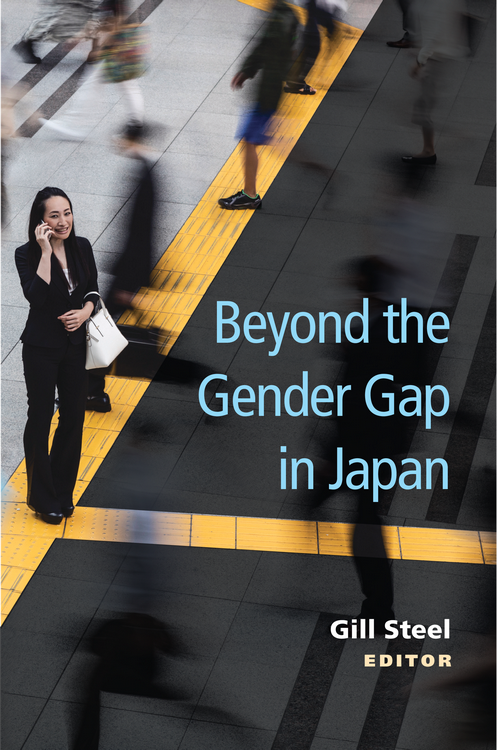Gill Steel - Beyond the Gender Gap in Japan
Here you can read online Gill Steel - Beyond the Gender Gap in Japan full text of the book (entire story) in english for free. Download pdf and epub, get meaning, cover and reviews about this ebook. City: Japan, year: 2019, publisher: University of Michigan Press, genre: Politics. Description of the work, (preface) as well as reviews are available. Best literature library LitArk.com created for fans of good reading and offers a wide selection of genres:
Romance novel
Science fiction
Adventure
Detective
Science
History
Home and family
Prose
Art
Politics
Computer
Non-fiction
Religion
Business
Children
Humor
Choose a favorite category and find really read worthwhile books. Enjoy immersion in the world of imagination, feel the emotions of the characters or learn something new for yourself, make an fascinating discovery.

- Book:Beyond the Gender Gap in Japan
- Author:
- Publisher:University of Michigan Press
- Genre:
- Year:2019
- City:Japan
- Rating:5 / 5
- Favourites:Add to favourites
- Your mark:
- 100
- 1
- 2
- 3
- 4
- 5
Beyond the Gender Gap in Japan: summary, description and annotation
We offer to read an annotation, description, summary or preface (depends on what the author of the book "Beyond the Gender Gap in Japan" wrote himself). If you haven't found the necessary information about the book — write in the comments, we will try to find it.
Beyond the Gender Gap in Japan — read online for free the complete book (whole text) full work
Below is the text of the book, divided by pages. System saving the place of the last page read, allows you to conveniently read the book "Beyond the Gender Gap in Japan" online for free, without having to search again every time where you left off. Put a bookmark, and you can go to the page where you finished reading at any time.
Font size:
Interval:
Bookmark:

Page i Why do Japanese women enjoy a high sense of well-being in a context of high inequality? Beyond the Gender Gap in Japan brings together researchers from across the social sciences to investigate this question. The authors analyze womens values and the lived experiences at home, in the family, at work, in their leisure time, as volunteers, and in politics and policy-making. Their research shows that the state and firms have blurred the public and the private in postwar Japan, constraining individuals lives, and reveals the uneven pace of change in womens representation in politics. Yet, despite these constraints, the increasing diversification in how people live and how they manage their lives demonstrates that some people are crafting a variety of individual solutions to structural problems. Covering a significant breadth of material, the book presents comprehensive findings that use a variety of research methodspublic opinion surveys, in-depth interviews, a life history, and participant observationand, in doing so, look beyond Japans perennially low rankings in gender equality indices to demonstrate the diversity underneath, questioning some of the stereotypical assumptions about women in Japan.
Gill Steel is Associate Professor at the Institute for the Liberal Arts, Doshisha University.
Page ii Michigan Monograph Series in Japanese Studies
Number 85
Center for Japanese Studies
University of Michigan
Edited by Gill Steel
University of Michigan Press
Ann Arbor
Page iv Copyright 2019 by Gill Steel
All rights reserved
This book may not be reproduced, in whole or in part, including illustrations, in any form (beyond that copying permitted by Sections 107 and 108 of the U.S. Copyright Law and except by reviewers for the public press), without written permission from the publisher.
Published in the United States of America by the
University of Michigan Press
Manufactured in the United States of America
A CIP catalog record for this book is available from the British Library.
Library of Congress Cataloging-in-Publication data has been applied for.
ISBN 978-0-472-13114-3 (hardcover : alk. paper)
ISBN 978-0-472-12460-2 (e-book)
Gill Steel
Gill Steel
Mito Akiyoshi
Kumiko Nemoto
Yuko Ogasawara
Linda Hasunuma
Kimiko Osawa
Yuki Tsuji
Susan Pavloska
Hiroko Takeda
Mayumi Nakamura
Liv Coleman
Sherry Martin
Gregory W. Noble
Yoshiaki Kobayashi and Yuta Kamahara
Digital materials related to this title can be found onthe Fulcrum platform via the following citable URL:https://doi.org/10.3998/mpub.10028271
CEDAW Convention on the Elimination of All Forms of Discrimination Against Women
DAC Development Assistance Committee
DPJ Democratic Party of Japan (now defunct)
EEOL Equal Employment Opportunity Law
GEB Gender Equality Bureau
GII Gender Inequality Index
HC House of Councilors (Upper House)
HR House of Representatives (Lower House)
ISSP International Social Survey Program
IVinstrumental variable
JCP Japanese Communist Party
JNFJapan Nursing Federation
JSP Japan Socialist Party
LDP Liberal Democratic Party
MMD multimember district
MOFA Ministry of Foreign Affairs
MP Member of Parliament
NGO nongovernmental organization
NPO nonprofit organization
ODA official development assistance
PR proportional representation
SDP Social Democratic Party of Japan, formerly the Japan Socialist Party
SEM structural equation modeling
SMD single member district
SNTV single nontransferable vote
It is my great pleasure to thank the outstanding scholars who contributed to this volume for making this project such an enjoyable and productive experience. I am grateful for the authors dedication and cooperation as we shaped our disparate research into an integrated book.
We were fortunate to be able to get together to share our expertise and gain feedback in workshops and conferences and to have fun doing so. This project hatched from a panel at the American Political Science Association Annual Meeting in 2015. Since then, authors have developed their research and presented earlier drafts of their chapters at various conferences, including the International Political Science Association in 2016, the Japanese Political Science Association in 2017, and at the Beyond the Gender Gap in Japan Symposium in 2017. We would like to thank the Nissan Institute, Oxford University for hosting this Symposium. We had interesting conversations and gained valuable feedback at all of these meetings.
I acknowledge the grant and administrative support from the Jinbunkagaku Kenkyujo (The Institute for Study of Humanities and Social Sciences) at Doshisha University for the Women in Contemporary Japan Project, 2016-2018.
Many thanks also to Kate Marshall, Sandra Junn Havens, Lee Thomas, Gregory Poole, and Eriko Kushibuchi for their input and help. I would also especially like to thank Christopher Dreyer and the team at the University of Michigan Press.
Gill Steel
Japans Women Struggle as Representation Trails Saudi Sisters proclaims a typical newspaper headline (Takahashi and Reynolds 2015). Measures of gender equality confirm that Japana wealthy, secular country with a highly educated populationhas few female politicians and ranks even lower than many developing countries: in 2018, Japan placed 165th of the 193 countries on the Inter-Parliamentary Unions list of women in national parliaments (Inter-parliamentary Union 2018). This low level of representation is one of the reasons that Japan performs poorly on both the World Economic Forum Global Gender Gap Index (in which Japan ranked 114 of the 144 countries on the 2017 index) and on the United Nations Development Programs 2016 Gender Inequality Index (17th of the 188 countries). Moreover, there are few women in the managerial ranks of the corporate world.
Much previous research explains the policies and practices that contribute to this situation and suggests measures that could be taken to reduce the inequality. What is puzzling, though, is that despite the inequity in a system that places unsustainable burdens on women (Schoppa 2006, 183), most Japanese women do not feel that they are struggling; they do not feel powerless and frustrated. Although a small number of women have mounted legal challenges against various egregious instances of discrimination, these have remained a minority concern. Most studies show that Japanese women are happier than men and enjoy their lives more (Inoguchi and Fujii 2009; Tiefenbach and Kohlbacher 2013). And while this is the case in many countries throughout the world (Helliwell, Layard, and Sachs 2015), it is particularly the case in Japan (Genda 2016).
Why do women enjoy a high sense of well-being in this context of inequality? In this volume, we do not analyze subjective measures of well-being Page 2 or happiness using the indices of happiness (see, for example, Holthus and Manzenreiter 2017). Instead, we examine various aspects of the lived experiences of women. Two common themes emerge from our analyses: first, the blurring of the public and the private in postwar Japan has constrained individuals lives, and the various ways in which the state and firms do this in their attempts to influence womens (and mens) lives emerge in many of the chapters throughout this volume. The second major theme is that, despite these constraints, Japan is changing and a diversity of experience now exists among Japanese women that is not fully captured by conventional measures of gender equality. Our research uncovers change across social and political life, but we also find that this change is not uniform: while some areas have experienced rapid change, other areas have experienced virtually none.
Next pageFont size:
Interval:
Bookmark:
Similar books «Beyond the Gender Gap in Japan»
Look at similar books to Beyond the Gender Gap in Japan. We have selected literature similar in name and meaning in the hope of providing readers with more options to find new, interesting, not yet read works.
Discussion, reviews of the book Beyond the Gender Gap in Japan and just readers' own opinions. Leave your comments, write what you think about the work, its meaning or the main characters. Specify what exactly you liked and what you didn't like, and why you think so.








